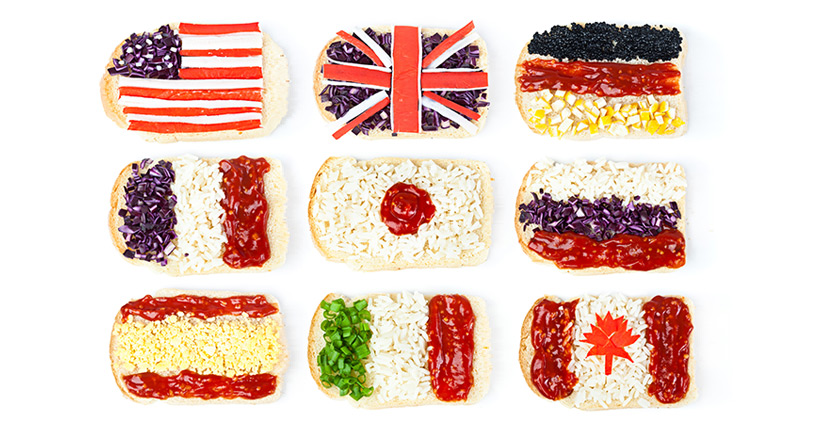 The National Restaurant Association’s (NRA) “What’s Hot: 2016 Culinary Forecast” included not one, not two, but three ethnic cuisine-related trends in its Top 20 roundup.
The National Restaurant Association’s (NRA) “What’s Hot: 2016 Culinary Forecast” included not one, not two, but three ethnic cuisine-related trends in its Top 20 roundup.
From “ethnic-inspired breakfast items” (#16) to “authentic ethnic cuisine” (#12) to “ethnic condiments /spices” (#11), it’s clear that the demand for global cuisines on restaurant menus isn’t just a passing fad, but rather is here to stay. The NRA recently took a closer look at the movement in its Global Palates report.
Let’s hone in on the findings, along with highlighting tips for how restaurants can capitalize on the trend.
What’s Trending in the World of Global Eats?
The NRA offers up the following highlights regarding how Americans are engaging with global cuisines:
• 66 percent of diners eat a wider variety of international foods than they did five years ago.
• 80 percent eat ethnic cuisine at least once a month.
• 17 percent eat ethnic cuisine at least seven times a month.
• 29 percent tried a new kind of ethnic food in the last year alone.
Where are these consumers most likely to try new ethnic cuisines, according to the report? Restaurants. In fact, restaurants are the primary point of contact and access for diners when it comes to experiencing new ethnic cuisine.
The question naturally follows: Which international foods are consumers craving in particular, and how do they prefer to eat them? NRA data also sheds light on these questions, including the following:
• Italian, Mexican and Chinese still stop the list when it comes to both familiarity and frequency of eating, while Ethiopian, Brazilian/Argentinean, and Korean lag behind as the least-known international cuisines.
• Among cuisines most likely to be taken out or delivered by restaurants, Chinese was the clear winner, followed by Mexican and Italian. Meanwhile, Ethiopian bested all of the also-rans when it came to convenience- and grocery-store takeout options.
• Sushi, Thai, Vietnamese, Brazilian/Argentinean, Greek and Southeast Asian were most likely to be consumed on restaurant premises.
Tips for Embracing Ethnic Cuisine in Your Restaurant
Being aware of these trends is one thing; deriving actionable insights from them is another. Luckily, Global Palates offers plenty to learn and apply, including the following:
• For starters, while 85 percent of diners prefer to eat ethnic cuisine in establishments focused on that specific cuisine, a full 75 percent enjoy the incorporation of ethnic cuisine into mainstream menus.
So while changing the concept of your restaurant is unlikely to make sense, incorporating even a few ethnic-inspired items into your current menu is likely to appeal to the majority of your diners. Appetizers are a great entry point, with ingredients like aioli, cilantro, and Pico de Gallo viewed as particularly strong emerging flavors.
• Conversely, while consumers may be open to new flavors, they’re less likely to be open to unconventional ingredients. Only 25 percent of diners revealed a preference for trying edgier new ingredients, such as ants, brains and snails.
• While consumers are willing to sample ethnic foods over traditional foods for a variety of reasons — from simply wanting to try something new to the desire to learn about different cultures — consumers are also increasingly telling us that they like to feel connected to the foods they eat.
43 percent of diners revealed that they enjoy eating ethnic cuisine which relates to their ancestry and/or heritage. Offering up information and stories about menu item can help consumers feel even more informed and engaged by your offerings.
• Last but not least comes the issue of customization. One thing we know about today’s consumers — across the various dining segments — is that they want their food their way.
The ethnic cuisine segment is no different. 56 percent of consumers indicated that they choose to customize ethnic options to fit their particular tastes. The clear mandate for restaurants? The more you support their ability to do so, the more likely you are to retain their business.
Certainly, the ethnic cuisine trend — as further evidenced by recent NRA data — represents significant opportunities for restaurants ready, willing and able to capitalize on these trends.
The good news? You don’t have to overhaul your restaurant theme or menu to see positive changes. Even adding one or two ethnic-inspired items will appeal to diners while keeping them coming back to see where you’ll take them next.